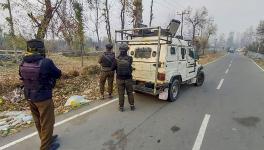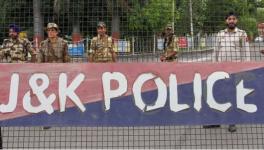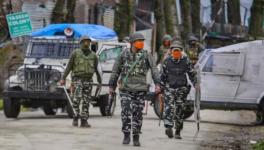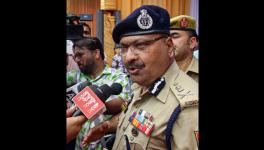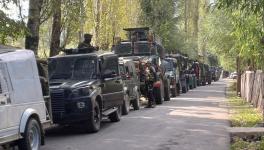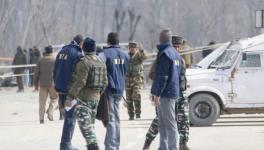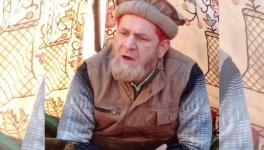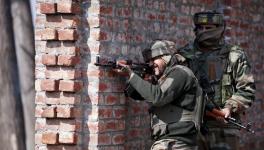Tales of Burhan Wani’s Aides: Before the Tipping Point
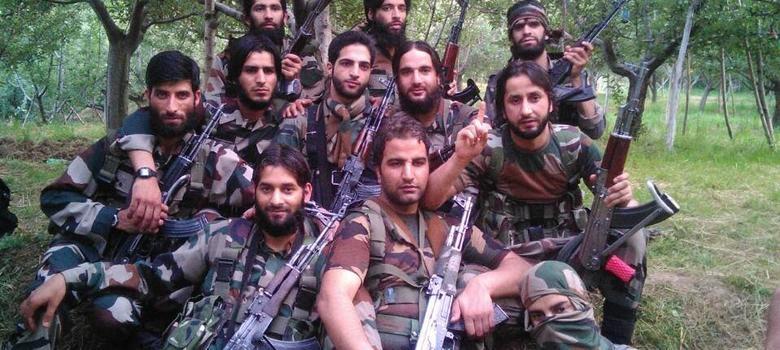
Three years ago, on July 8, 2016, the death of Hizbul Mujahideen’s ‘commander’ Burhan Muzaffar Wani sparked off an unprecedented upsurge of protests and repression in Kashmir. He had attained a kind of popularity rarely seen among the Kashmiri militants. He led a small group of youth – just 11 of them – but they inspired a larger than life charisma. He had recruited this group and fostered them himself. Tackling his group became one of the biggest challenges for the government forces. Burhan recruited and fostered his own cadre.
How did this happen? Who were the other 10 members of his group? Was he just the right man at the right time? Or was there something more?
Formation of Burhan’s Group
Born in a middle-class family, Burhan Muzaffar Wani had been a good student and passed his class VIII exam with 99% marks. He was calm, and sober and loved by everyone in Shareefabad, an area of Tral hamlet in South Kashmir’s Pulwama district, almost 43 kilometres from Srinagar, the summer capital of Jammu and Kashmir.
Growing up in a conflict zone like Kashmir is fraught with difficulties. Many people’s lives have changed completely after witnessing extreme violence, torture and oppression. Burhan’s too is a similar story.
Kashmir observed a huge mass uprising after the killing of a 16-year-old boy Tufail Matto on June 11, 2010, when security forces shot a teargas canister which killed him on the spot. He was a class X student.
More than 124 civilians were killed within a span of four months. Protests were witnessed from every corner of the Valley including Tral. Government forces had established new checkpoints at many places across Tral.
The Recruiter
Burhan’s father, 52-year-old Muzaffar Ahmad Wani, who heads the Government Girls’ Model Higher Secondary School at Tral, Pulwama, recalls an incident that changed his son.
In the last week of September 2010, a female neighbour from Burhan’s village died. As per the Kashmiri and Islamic culture, for three days, neighbours prepare lunch and dinner for the family of the deceased. When it was the turn of Burhan’s family to serve lunch and dinner, Muzaffar asked his elder son Khalid Muzaffar to go and buy the required items. “There was a wholesaler and a meat shop who were selling things from home during the emergency. I asked Khalid to take his bike and get the items at the earliest and pick up Burhan from his maternal grandparents’ home. He could help in serving meals to the gathering,” said Muzaffar.
Burhan was at Darsara village located in Tral. Crossing many razor wires and other barricades placed by the forces, and after passing through the lanes which had tyres burnt by the protesters to mark the protest against the killings, Khalid managed to get the stuff and went to fetch Burhan, riding a newly purchased bike. Burhan, who was second among the four siblings, returned with his brother.
“They tried to take safer routes back, but they were stopped by the forces at a checkpoint on the Amira Abad-Tral road,” Muzaffar said.
This checkpoint was manned by the Central Reserve Police Forces (CRPF), Special Officers Group (SOG) of J&K police. The security personnel asked Khalid to get cigarettes and chewing tobacco for them, as it was difficult for them to enter any village due to protests by the locals against the killings by the government forces. Khalid managed to get whatever they asked for. But as they started to leave, some of the security personnel started beating up the brothers. Burhan pulled himself off the bike and escaped. Some time later, Khalid too managed to escape and returned home.
“He entered with torn clothes and injuries on his body. He described the whole episode to us,” said Muzaffar.
Muzaffar called his in-laws and inquired about Burhan and was relieved to know Burhan was with them. He decided to get Burhan home and drove straight to Dadsara. While returning home, Burhan kept asking him: “We helped those cops, why did they still beat us?”
Muzaffar didn’t realise how deeply this incident had affected Burhan. Whenever they would sit to eat, Burhan would tell his father that he could have killed them if he had had a gun. Muzaffar always tried to change the topic, but it clearly didn’t help.
On October 16, 2010, like any other day, Burhan asked his mother for lunch. He finished his lunch quickly and went to his room.
Burhan packed a few clothes in a bag and told his mother that he was going to a tailor for getting the clothes altered. Burhan left with his distant relative, Adil Mir, five years older to him, and never returned home.
Soon, the duo joined Hizbul Mujahedeen (HM). Burhan mostly remained with Adil who eventually became HM’s commander and was Burhan’s mentor as well.
In 2013, Burhan’s name appeared for the first time on social media, when a recording went viral on social networking websites in which a militant, Aijaz Ahmad Bhat, while fighting during an ambush, made his last wish saying “Ask Burhan to pray for forgiveness for me”. He was eventually killed. He was also known as Arif Khan, and later became popular as Burhan Bhai (brother Burhan).
Adil was killed in 2014. Muzaffar and his family were worried about Burhan’s survival. But Burhan surprised the world by taking over as HM’s new and the youngest commander. Soon, Burhan became a household name in Kashmir. His social media pictures and videos became the main reason for the rise in militant recruitment in Kashmir.
The Picnic
On April 13, 2015, Khalid asked his mother to prepare a few dishes as he along with his friends were going for a picnic. “We bought mutton, chicken and other items for him. It was after a long time he had decided to go for a picnic,” said Muzaffar.
Khalid and his three friends had planned to go to Kamla forest of Buchoo belt and meet Burhan there and take the dishes for him. Till afternoon, no one had any idea of Khalid’s whereabouts. At around 4:30 pm, forces led an ambush in the forest. During the brief exchange of fire, Burhan and his associates managed to escape, but Khalid and his friends were captured.
Khalid’s friends were detained and when forces came to know that Khalid was Burhan’s brother, it is alleged that their attitude towards him changed. According to Muzaffar, they tortured him to death. Forces said he was killed during the ambush.
“If a person dies during the gunfight, his body must have bullet wounds. There was not a single mark of a bullet on his body, but the backside of his head was badly injured. It was continuously hit with gun-butt or something solid that caused his death. This type of injury clearly indicates torture and proves their statement wrong,” said Muzaffar.
News of Khalid’s killing spread like wildfire and people from Tral took to the streets and started protesting. People from different locations reached Tral to attend Khalid’s funeral.
The Don
Sabzar Ahmad Bhat, then 30-year-old, mutual friend of Khalid and Burhan was in his orchard nearby Kamal forest, helping his father Ghulam Hassan Bhat, a farmer by profession. “We heard some gunshots, but we were not sure where the sound was coming from,” said Hassan.
Both started towards home after finishing the work when, on the way, Sabzar came to know about the killing of his friend Khalid. Sabzar went to Shareefabad to attend the funeral of his friend, with whom he used to spend most of his time on Sundays.
On reaching, he saw Khalid lying lifeless on a wooden bed, under a coloured blanket with his head wrapped in blood-soaked bandage, surrounded by thousands of people. He returned home and went to his room without eating his dinner. “I was waiting for him to have dinner together, but he didn’t eat anything. His eyes were red from crying,” said Jaana Begum, his mother, with tears in her eyes.
Overnight, government authorities ordered heavy deployment of forces in Shopian, Pulwama, Anantnag, Kulgam, districts of South Kashmir, to curb the protests against Khalid’s killing.
Next day, despite the heavy presence of the forces, protesters took to the streets. Sabzar had breakfast with his family and left for the orchards to finish some pending work. He returned and had lunch in hurry. Once done with lunch, Sabzar asked his sister, Masrat Hassan, to give him a few things.
“He asked me to give Pheran (Kashmiri Long Gown), socks, skullcap, shoes, handkerchief,” said Masrat.
He told Jaana that he was going to see one of his relatives staying in the village next to his. Heavy clashes between protesters and government forces were going on in Tral hamlet.
Sabzar joined the stone-pelters at the Main Chowk, Tral, where he was popularly known as Sahba Don. To disperse the growing number of pelters, the forces fired pellets, bullets and tear gas. While the rest ran for cover, Sabzar, who had a heavy built, stood his ground.
One of the eyewitnesses (wishing anonymity) said that Sabzar was standing in the middle of the road like a wall. He hit a Central Reserve Police Force (CRPF) man, managed to snatch his assault rifle and disappeared in the forest. He then joined slain Khalid’s brother Burhan Wani.
This marked the beginning of formation of Burhan’s group which kept growing slowly. Several members of the group were those who had been tortured before they joined the armed movement.
The Shepherd
Same was the case with Burhan’s close aide, 23-year-old Saddam Padder, who was famous as a shepherd and also a cricketer in his village, Heff Shirmal, in South Kashmir’s Shopian district.
Eldest among four siblings, Saddam was a clever entrepreneur. His trade skills of livestock were exceptional. Saddam dropped out of his studies after passing grade X exams and would join his father Ghulam Mohi-U-Din Padder, a 55-year-old man, in the fields, and would also do livestock trading.
In the winter of 2013-2014, many people from Heff Shirmal joined the armed movement, and a few of them were Saddam’s friends.
Operational Deputy Superintendent of Police (DSP) Irshad Ahmad Rather, then posted at Imam Sahab SOG camp, would allegedly call many people in this connection. Many times, he would call Saddam and reportedly ask him to become an informer.
“They would beat him up there and ask him to tip them about his friends who had taken up arms,” said Mohi-U-Din.
About two days before Saddam took up arms, he was asked to appear in the police station by DSP Irshad, recalls Mohi-U-Din. Saddam’s reply was, “I will go day after tomorrow,” which was September 14, 2014. Saddam woke up and like on other days, took his cattle for grazing to a nearby meadow, while his father worked in the field.
On returning home in the evening, Mohi-U-din was informed by a neighbour that the cattle were still there, but Saddam was not to be seen. Mohi-U-Din’s 40-year-old wife, Feroza Begum, told him that Saddam had come home around 2 pm, but had left almost immediately, wearing his new shoes. Mohi-U-Din went to all of his relatives’, friends’ place where Saddam could have possibly gone, but he would return without any news every day.
After a week, he received a call from the police station and was informed that Saddam had joined the Hizbul Mujahedeen. He eventually joined Burhan’s group.
Saddam wasn’t the only one affected by DSP Irshad’s dealings. There were two more youngsters who allegedly witnessed the same.
The Fast Bowler
Waseem Ahmad Shah, a 22-year-old boy was a famous left-hand seamer of Heff Shirmal and had won several awards for his bowling in inter-school matches. He was a student of standard XII at Bijbehara Higher Secondary in 2012 when for the first time he was called by DSP Irshad for details of his classmate, Ashiq Ahmad Lone, who had joined the armed resistance movement.
His father Ghulam Mohammad Shah, a 55-year-old farmer, went to the camp to inquire about his son where he was told that he would be released soon.
However, Waseem was kept in custody for 15 days. “For those 15 days, DSP tortured him brutally. He tried all the methods of torture on him to make him reveal the details of his friend, which he didn’t have in the first place,” recalls Mohammad.
During this detention period, Waseem was to appear for his class XII exam, which he missed, in spite of his family’s pleas to the DSP. His father received an award on his behalf at Shopian Higher Secondary School for his good performance. When Waseem was finally released, he decided to quit studying.
His father decided to send him out of J&K so that he stays out of trouble, but was reportedly denied permission by DSP Irshad. Fearing being set up by the police, he decided to stay quiet, and sold a piece of his land to set up a general store for Waseem.
After a few months, Ashiq was killed in an ambush and the top commander of militant outfit Lashkar-e-Toiba (LeT), Abu Dujana, escaped the ambush. In 2013, Waseem was detained again by DSP Irshad. This time, he wanted details of Abu Dujana.
As a routine, he released Waseem again after 15 days.
But this time the torture was more brutal. “He had torture marks on his whole body. His soles had burn marks. For a month he was on complete bedrest. DSP didn’t let Waseem study nor did he let him work peacefully,” said Mohammad with tears in his eyes.
On March 27, 2017, Waseem was in his shop and one of his friends was sitting with him. At around 11 am, DSP Irshad called Waseem and asked him to come to the camp.
“He abused him over the call. He was pushing Waseem to be his informer which he would refuse. Waseem dropped the call and gave the keys of the shop to his friend to deliver it to his home,” Mohammad said. Waseem left his village and joined LeT.
Later, on July 13, 2018, Abu Dujana was killed in an ambush.
The Driver
On October 9, 2012, Adil Khanday, then a 21-year-old boy was detained by DSP Irshad. Like Waseem, one of Adil’s friends, Arshid Ahmad Sheikh, a resident of Haripora village of Shopian district, was a militant. “DSP told me he wants my son to help him to trap Arshid,” said Ghulam Hassan Khanday, his 55-year-old father who is a farmer.
For at least 19 days, Adil was in DSP Irshad’s custody. All through, Adil was tortured brutally. Finally, on October 26, Adil was released. He wasn’t able to walk, his whole body had torture marks. He, too, spent a month in bed to recover from his injuries.
Once out of the custody, Adil dropped his studies and started driving a rented cab to earn for his family. In 2013, Adil was called to the same SOG camp of Imam Sahab after every three days. This went on for a long time. Finally, he stopped driving the cab, as his work would get disturbed due to his visits to the camp.
For some time, Adil helped his father in farming. In 2014, he joined as a cab driver at Rainbow School at Shopian. Calls from the camp continued, greatly affecting his work.
On August 31, 2014, after driving back from school in the evening, Adil asked his mother Gulshan for a cup of tea. Soon after finishing his tea, he told Gulshan that he was going to see one of his relatives. Next day, his family came to know that Adil had joined the Hizbul Mujahedeen outfit.
The Game Changer
In May 2009, Kashmir witnessed a huge mass uprising due to the rape and murder of a 22-year-old and a 17-year-old. Both were residents of Bongam Shopian. The accused in the case were armed forces personnel.
Waseem Ahmad Malla, then 19-year-old boy and a resident of Pehlipora Trenz, Shopian, would participate in the protests. He would go from village to village and inform people how to keep an eye on strangers in the village.
In 2010, Waseem tried to join the armed resistance movement, but on the same day, he was detained by the cops in South Kashmir’s Anantnag district. His father Mohammad Iqbal Malla, a 45-year-old farmer, tried to get him released, which took over two months.
In 2011, Waseem finished his B.A. course and in 2012, he enrolled for B.Ed. at Kashmir University. On April 13, 2012, Waseem went to Pargochi, a small village one kilometre away from Pehlipora, and snatched a rifle from two cops who were deployed there and took refuge in the woods.
“There were no militants then in Shopian district. People approached Waseem and eventually joined the armed resistance. He created the HM outfit in Shopian belt. He changed the armed resistance movement in Shopian. Anger among the public was intense due to the rape and murder of two girls. Waseem created this wing and showed people a way to voice their dissent. Later, he joined Burhan,” Iqbal said.
The Cop
Naseer Ahmad Pandit from Kareemabad, Pulwama, joined the J&K Police at the age of 22, and served for five years as a constable.
Naseer would try and help people get justice sooner while being in the system. According to his father Ghulam Rasool Pandit, a 60-year-old farmer, Naseer emotionally connected with the people of his community (Kashmir).
“He attended funerals of many civilians and militants even as a policeman. He would talk about the injustice happening in Kashmir with me. He would say that he wanted to bring in a change, but alone, he couldn’t do much,” recalls Rasool.
On March 27, 2015, Naseer was posted as a security guard at the residence of Altaf Bukhari, Peoples’ Democratic Party (PDP) MLA and I&B minister, in Srinagar.
“He had spent only 15 days as his security guard. During these fifteen days, he became a favourite of Bukhari,” Rasool said.
At 1:30 pm, he decamped with two AK 47 rifles from Altaf Bukhari’s residence and reached his village where two boys, 24-year-old Afaq Ullah Bhat and 20-year-old Tariq Ahmad Pandit, were waiting for him. All three disappeared and joined the militant ranks.
Naseer became popular in the group for training other associates as he was a trained policeman.
The Islamic Scholar
Before joining hands with Naseer, Afaq finished Masters in Arabic from Kashmir University in 2014. Afaq was a very religious person. He would recite the Quran five times a day and never missed a prayer.
According to his father, Wali Mohammad Bhat, a policeman, Afaq was a very silent boy who would never complain, even when in pain. He would participate in all the religious gatherings in and around Pulwama district.
Like Naseer, he was pained by civilian killings by the government forces. He had kept a notebook in which he would write the details of civilian killings.
Tariq Ahmad Pandit, the other boy, was studying in the first year of his B.A. at Government Degree College for Boys, Pulwama. Earlier in 2010, 2013 and in 2014, he was detained by the police in cases related to stone-pelting.
Tariq was the only militant in Burhan’s group who was captured alive. He was arrested by the police and the army on May 28, 2016, in Pulwama district.
The Engineer (A Militant without Grave)
One of the rarest cases in the history of new age militancy is of Wajid Ramzan Dar, a 25-year-old boy and resident of Arreh Kulgam. Wajid dropped his studies in standard XII and started working in his orchards and crop fields.
His father, Mohammad Ramzan Dar, a 68-year-old retired senior accountant of J&K finance department, tried to convince him to complete his studies, but Wajid would spend most of his time repairing machines, radios, bikes and mobile phones.
“Even without any training, he was good at fixing the machines. People would come to him with different gadgets and he would repair them without charging a single rupee,” says Ramzan.
Wajid was very disturbed whenever he saw forces in his village. He would intervene if forces stopped people to check their identity cards. “He would always say that the forces are trying to humiliate the innocent villagers without any reason,” said Ramzan. Wajid would take money from his father and give it to the needy people. He was very famous in his village for such acts.
On May 11, 2014, Wajid, after finishing his lunch, went out for a walk and never came back. It was the last day when Wajid was seen in his village. After a few days of his disappearance, Ramzan figured out that he had joined the armed outfit. But there was no confirmation of his joining.
“Like other militants, there were no pictures of him on social media. It was a confusing situation for me,” says Ramzan.
Finally, in the last week of May 2015, when Burhan’s group picture appeared on the internet, Ramzan got a confirmation. There was only one member who was wearing a mask, and that was Wajid alias Anees.
There is no proper confirmation about whether is he alive or has been killed.
“I have talked to many people. Some said he was killed in an ambush in a forest; others tell different stories. We haven’t received his dead body. But I have accepted that he is dead now,” said Ramzan with tears in his eyes. He is the only militant in Burhan’s group whose whereabout are still unknown.
The Carpenter
The last man of Burhan’s group was Abdul Lateef Ahmad Dar, a 32-year-old resident of Dogripora, Pulwama. Before he took up arms, he was a carpenter, a skill he had learnt from his father, 50-year-old Ghulam Hassan Dar.
His mother, Fatimah Akhter (45), narrated the tale of why her son, who was the main source of income in the family picked up arms. Before working with his father, Lateef worked in an army mess from 2008 to 2012. During this time, in 2010, he became a member of Hurriyat (G).
On March 8, 2014, militants shot dead octogenarian Ghulam Mohammad Dar in Dogripora at his residence. His son was a sarpanch. In this regard, police on March 30, 2014, detained Lateef in Marhama, Anantnag.
“Police detained him and said that he had helped militants to kill Mohammad Dar. This was a complete lie. But we were helpless, we couldn’t do anything,” Fatimah said.
Lateef was kept in Awantipora police station for a day. Later, he was shifted to SOG camp Budgam, which is known for torturing people. For 11 days, Lateef was kept there. His father went to see him. “My husband collapsed when he saw his son with severe torture marks. Lateef was in extremely bad shape,” Fatimah said with tears in her eyes.
Lateef was shifted back to Awantipora police station where he was kept for a month and later, in May, he was shifted to the Central Jail. From May to October, Lateef was lodged in central jail. In the first week of October, on the occasion of Eid, Lateef was home for a few days. “After spending five days at home, on October 10, Lateef went for Maghrib (evening) prayers,” says Fatimah.
But Lateef didn’t come back. What returned after a few days was a man wearing a helmet who handed over a letter to Lateef’s eight-year-old cousin sister according to which he had joined the armed resistance movement. He was the last militant of Burhan’s group killed by the government forces on May 3, 2019.
Get the latest reports & analysis with people's perspective on Protests, movements & deep analytical videos, discussions of the current affairs in your Telegram app. Subscribe to NewsClick's Telegram channel & get Real-Time updates on stories, as they get published on our website.









